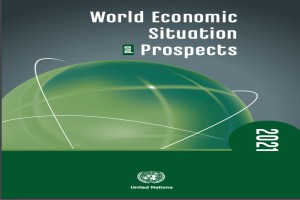
Child marriages will see a global uptick as female labour force participation falls
New York: Economic growth tumbled worldwide World gross product fell by an estimated 4.3 per cent in 2020—the sharpest contraction of global output since the Great Depression, adding that in contrast, world output had shrunk by 1.7 per cent during the Great Recession in 2009, according to The World Economic Situation and Prospects 2021 – a report produced by the United Nations Department of Economic and Social Affairs (UN DESA).
The report says that massive and timely fiscal responses prevented a Great Depression-like economic catastrophe worldwide. The fiscal outlays from the developed countries represented nearly 80 per cent of the $12.7 trillion of fiscal stimulus worldwide, with Germany, Japan and the United States accounting for more than 50 per cent of all the fiscal stimulus worldwide.
The group of 46 least developed countries (LDCs), for example, collectively managed to increase direct and indirect fiscal support by only 2.6 per cent of their GDP, while the size of the stimulus for the developed countries averaged 15.8 per cent of their GDP. In dollar terms, stimulus spending per capita averaged nearly $10,000 in the developed countries, while it amounted to less than $20 per capita in the least developed countries. That is, for every additional dollar per capita of stimulus that the LDCs managed to spend, the developed countries spent nearly $580 per capita on stimulus.
The disparity in the size of the stimulus between the LDCs and the developed economies dwarfed the income disparity between these two group of countries. The per capita income of the developed countries is only 30 times larger than the per capita GDP of the least developed countries.
The pandemic clearly hit the developed economies the hardest, given the strict lockdown measures that many countries in Europe and several states of the United States of America imposed early on during the outbreak. Output in developed economies is estimated to have shrunk by 5.6 per cent in 2020, with growth projected to recover to 4.0 per cent in 2021. A renewed outbreak, however, set off new lockdown measures in the third quarter of 2020 in many countries in Europe, making a quick recovery more unlikely.
The developing countries experienced a relatively less severe contraction, with output shrinking by 2.5 per cent in 2020. Their economies are projected to grow by 5.7 per cent in 2021. The least developed countries (LDCs) saw their gross domestic product (GDP) shrink by 1.3 per cent in 2020, with growth expected to reach 4.9 per cent in 2021.
The countries in Latin America and the Caribbean and South Asia experienced the sharpest declines. In contrast, the economies in East Asia fared relatively better than those in all other developing regions, with GDP expanding by 1 per cent in 2020. On the back of China’s quick – and robust – recovery, the East Asian economies are forecast to grow by 6.4 per cent in 2021.
The economies of the Group of Twenty (G20)—which account for nearly 80 per cent of world output—contracted by 4.1 per cent, mirroring the overall performance of the world economy. Only China, among G20 members, managed to register positive growth in 2020. It will remain critical that the G20 economies return to the trajectory of growth, not only to lift the rest of the world economies but also to make the world economy more resilient to future shocks.
The pandemic unleashed itself on the world at a low point in multilateral cooperation. Lack of effective cooperation, pervasive mistrust and blame games constrained the multilateral response to the pandemic. In the initial response to the crisis, many countries increased trade protection, and restricted exports of PPE and other medical supplies, which weakened collective responses to the crisis. Despite the efforts of the G20, IMF and a few multilateral institutions, the overall global economic responses to the crisis remained inadequate. Most developing countries—many with severe financing constraints and huge debt—have been left on their own to face the worst crisis in a century.
Along with growing fiscal deficits, total public debt worldwide increased by an estimated $9.9 trillion in 2020. This is the largest increase in public debt since the Second World War. Governments around the world borrowed from the future to minimize the impact of the crisis on the current generation.
International trade contracted in 2020 for the first time since the global financial crisis, as the COVID-19 crisis triggered widespread lockdowns, severely impacted factory output, disrupted travel and depressed demand worldwide. According to UN DESA estimates, the volume of global trade in goods and services fell by 7.6 per cent in 2020. Following a massive contraction in March and April, trade recovered in the second half of the year driven by a rebound in economic activities in East Asia.
As global economic activity recovers, global trade activity will improve but, until 2022, it is projected to remain below pre-pandemic levels. Hence, the recovery in trade is expected to continue over the next two years. The UN DESA baseline scenario projects that global trade in goods and services will grow by 6.9 per cent in 2021 and 3.7 per cent in 2022. There are both upside and downside risks to this forecast. If vaccines help bring the pandemic under control, the trade recovery, especially in tourism services, could be stronger than expected thanks to pent-up demand. On the other hand, if movement restrictions remain in place and uncertainties over the pandemic persist, cross-border trade activities will remain subdued in 2021.
The Great Disruption choked global and domestic supply chains. Weaker consumption and investment spending during most of the year dampened inflationary pressures around the world. Consumer price inflation is projected to remain low in 2021 as unemployment will likely remain high relative to pre-crisis level in most economies. By April, full or partial lockdown measures had affected almost 2.7 billion workers, representing about 81 per cent of the world’s workforce. The aggregate unemployment rate in the Organization for Economic Cooperation and Development (OECD) reached 8.8 per cent in April 2020, before falling to 6.9 per cent in November.
Unemployment rates still remain high relative to precrisis levels in all developed countries. The COVID-19 crisis has also wreaked havoc on the labour markets in the developing world. By mid-2020, unemployment rates had quickly escalated to record highs: 27 per cent in Nigeria, 23 per cent in India, 21 per cent in Colombia, 17 per cent in the Philippines and above 13 per cent in Argentina, Brazil, Chile, Saudi Arabia and Turkey.
Women have been particularly hit by the pandemic, as they account for more than 50 per cent jobs in labour-intensive service sectors, such as in retail trade and tourism, where working remotely is often not an option for many workers. While some crimes have registered a decline, women and girls are increasingly becoming victims of violence during the implementation of the lockdown measures.
It is also likely child marriages will see a global uptick against the backdrop of falling female labour force participation and rising poverty. The long-term consequences of the crisis will be equally severe. The pandemic will likely accelerate the pace of digitalization, automation and robotization, which will further depress labour demand in the medium term. While productivity will experience some growth in economic sectors embracing automation, average productivity growth will falter. Declining investments in fixed capital, low average productivity growth and lower labour-force participation rates will further depress potential output of the world economy.
The increasing vulnerability of hundreds of millions of people to economic, health and environmental shocks underscores the need for universal social protection. Stagnant wages and income—constraining levels of consumption and access to basic services—have made vulnerability an existential reality for millions in both developed and developing countries. Ubiquitous income and wealth inequality, with people at the top of the distribution enjoying unprecedented prosperity—while the bottom 40 per cent of the world’s population lack access to basic food, shelter and health care—makes universal social protection not only a moral issue, but also an economic imperative, says the UN report.
– global bihari bureau





